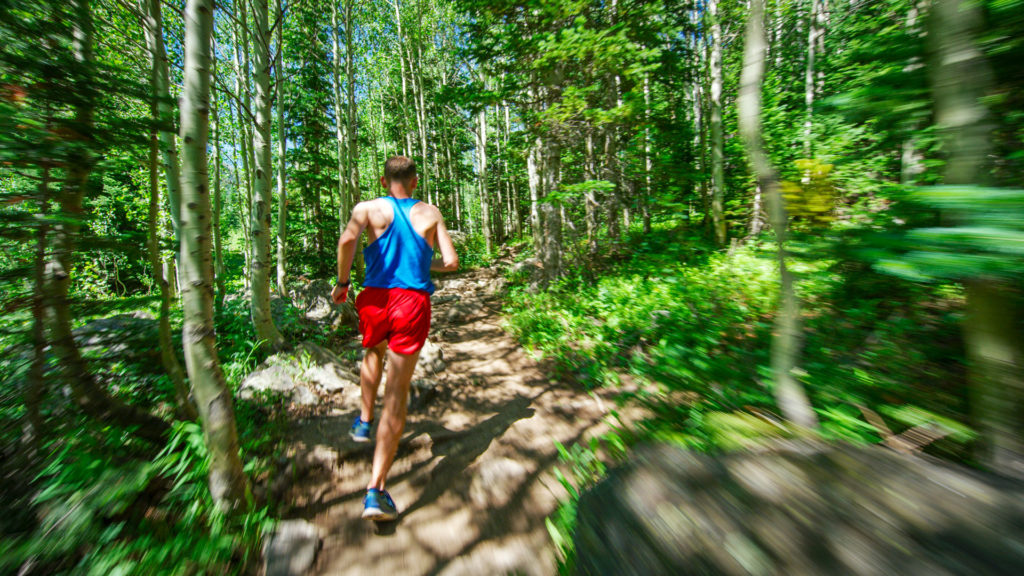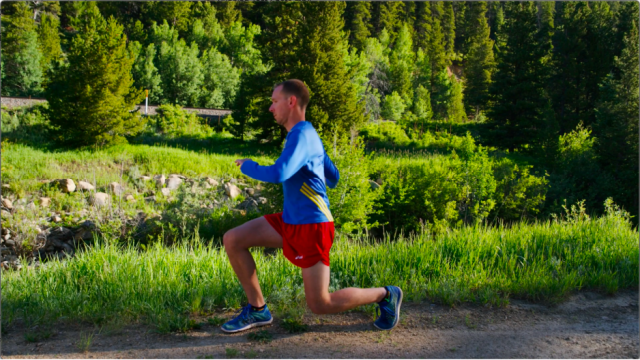I consider myself a lucky runner: while I used to be injury-prone, I’ve turned things around and now don’t have to worry much about running injuries today.

Since I started running back in 1998, I’ve suffered through nearly every running injury that you can imagine:
- IT Band Syndrome
- Plantar fasciitis
- Severe arch strains
- Sacroiliac joint misalignment
- Achilles tendinopathy
And probably a few that I’ve purposefully forgotten…
As my mileage progressed from about 30 per week as a high schooler to more than 85 as a post-collegiate runner, my injuries became more frequent (and took longer to heal).
These overuse injuries prevented me from racing, participating in workouts with my team, and enjoying the sport that I love.
But after I spent six months with ITBS unable to run a step, I knew something needed to change.
My training evolved and I added strength exercises to my program. But not just any strength exercise, I focused on those that were runner-specific. In other words, those exercises that were especially helpful for endurance runners.
Now, running injuries are technically repetitive stress injuries. And if we can better manage the negative effects of repetitive stress, we’ll get far fewer injuries.
Strength training accomplishes this goal by:
- Strengthening muscles, allowing them to absorb repetitive impact forces
- Toughening connective tissues, making them more resilient to wear and tear
- Improving running economy, allowing you to run more efficiently with less wasted movements
But what happens when you’re not as strong on one side than the other?
How should you address muscle imbalances? What if one leg is clearly stronger and more coordinated than the other?
First, let’s determine if you should worry…
Are Muscle Imbalances Normal?
For many athletes, the words “muscle imbalance” leads to existential dread. Any imbalance will obviously make you slower and more likely to get injured.
But not all is lost! In fact, no runner is symmetrical. Even Usain Bolt, the fastest runner the world has ever seen, does not have a perfectly balanced stride. And about 90% of runners have an acceptable level of asymmetry.
I discussed this phenomenon, and why you should take your “ground contact time” metric from your smart watch with a grain of salt, in this video:
Ultimately, we must recognize that none of us are symmetrical. Some amount of uneven, unbalanced running is perfectly normal.
The real question becomes, how much asymmetry is normal?
Two tests now become important:
- Ground Contact Time: if your GPS watch measures this metric, make sure you’re less than 2% off from the 50% baseline. In other words, you should spend no more than 52% of the time on any leg.
- Single Leg Exercises: if you attempt any of the exercises below on both legs and have noticeable, substantial differences (based on your opinion) between your legs, then your asymmetry is something that should be addressed.
Even if you don’t have these problems, single leg exercises for runners are an important part of the injury prevention puzzle.
Single Leg Exercises for Runners 101
Single leg exercises are also called “unilateral training” (training on one leg). The opposite is “bilateral training” (exercises that require both legs).
Unilateral, single leg exercises add variety to your strength training and help you progress faster with bilateral exercises. After all, if your right leg is stronger than the left, it will “pick up the slack” during a squat or deadlift.
That imbalance is then made worse, greatly increasing your risk of a running injury.
Single leg exercises are the solution. By forcing you to work on one leg only, you’ll build equal competence in both legs. In effect, you’re disallowing your dominant, stronger leg to compensate for your weaker leg.
But single leg exercises for runners don’t just build equal strength. They also enhance:
- Balance (how stable you are on one leg)
- Proprioception (your sense of how your body moves through space)
- Coordination (how efficiently you move)
A great example is the Pistol Squat – a one-legged squat that you can see demonstrated in the ITB Rehab Routine. Many runners struggle with this movement not just because of weakness, but also due to a lack of coordination and balance.
That makes single leg exercises a powerful way to build equal strength, improve coordination and balance, and reduce (or remedy) muscle imbalances.
What’s not to love?!?
Single Leg Exercises Have Their Drawbacks

Ok, I spoke too soon. Unilateral exercises aren’t a panacea and they do have a major drawback.
Most importantly, single leg exercises do not help you produce more force. Producing more force against the ground is one of two ways to run faster (the other is to run with a higher cadence). So in a very important way, single leg exercises do not directly make you into a faster runner.
These workouts are more for correcting imbalances, increasing coordination, and prioritizing injury prevention. They make you capable to do the training that directly makes you into a faster runner.
To truly focus on strength and power, we must lift with our entire bodies and focus on force production (that’s what High Performance Lifting is all about).
While unilateral exercises have an important part in any runner’s strength training, they’re not the end goal and they’re certainly not the major element of how runners should get strong.
But if you’re injured (or injury-prone), they’re a crucial ingredient.
The Mace Routine: Single Leg Exercises for Runners
To ensure that you’re doing enough unilateral strength training, I’ve created a new routine that includes 8 single leg exercises for runners.
We’ll start simple on the ground but move to standing exercises, weighted exercises, and complex movements (like pistols).
Watch the Mace Single Leg Routine below:
1. Marching Bridge
Lie on your back with your feet flat on the ground. Lift your hips so there is a straight line from your shoulders to your knees. Extend one leg straight out, hold for several seconds, then put it back down on the ground and repeat. Make sure your hips don’t dip and keep your butt form sagging to the ground.
Perform 10-15 repetitions per leg.
2. Hip Thrust
Lie on your back with your feet flat on the ground. Lift your hips so there is a straight line from your shoulders to your knees. Lift one leg so your weight is all on one leg and your back. Lower your butt almost to the ground and thrust upward by activating your glutes and driving your heel into the ground.
Perform 20-30 repetitions per leg.
3. Hip Hike
Stand on your right foot. With your pelvis in a neutral position, drop the left side so it is several inches below the right side of your pelvic bone. Activate your right hip muscle and lift your left side back to its neutral position. A helpful cue is to imagine that your pelvis is a bowl and you’re tilting one side down.
Perform 20-30 repetitions per leg.
4. Front Step Up with Knee Drive
Stand several inches in front of an elevated platform. Step up with your right foot and drive your heel into the platform to step onto the platform. Drive your opposite knee up into the “running man” position. Maintain a tall posture and step down with the left foot.
Perform 10-20 repetitions per leg.
5. Side Step Up with Knee Drive
Stand several inches in front of an elevated platform but facing sideways to the platform. Step up with your right foot and drive your heel into the platform to step onto the platform. Drive your opposite knee up into the “running man” position. Maintain a tall posture and step down with the left foot.
Perform 10-20 repetitions per leg.
6. Pistol Squat
Pistols are one-legged squats. The key to a successful pistol squat is to not lean excessively forward, keep the motion slow and controlled, and make sure your knee does not collapse inward. Try to descend until your thigh is about parallel with the ground.
Perform 5-10 repetitions per leg.
7. One Leg Deadlift
Bend forward from the hip (not the spine or waist) while standing on your left leg and extending your right leg behind you for balance. Grip a weighted implement in the right hand. Keep your knee mostly straight (a small amount of bend is fine). Return to an upright position by activating the glutes.
Perform 8-12 repetitions per leg.
8. Hot Salsa
Hold a weighted implement above your head and lunge forward with your right leg, moving the implement in front of your right knee. Shift your weight to your right foot and lift your body up to the “runner position” while also lifting the medicine ball back to the starting position. Repeat on the opposite side in one controlled movement. Be sure to maintain a straight back.
Perform 10-20 repetitions total.
Dial in Your Injury Prevention

Many runners lack the balance, coordination, and single leg strength to stay healthy. Without that strength, it becomes overly challenging to complete workouts and long runs that make up the most important parts of training for endurance runners.
A healthy dose of single leg exercises during the week is a great solution.
But of course, it’s not the full picture. Your running (not lack of strength training) is what makes you most susceptible to running injuries.
Ask yourself:
- Are my workouts appropriate for my fitness level, goals, and where I am within the season?
- Does my long run progression make sense?
- Am I starting my training cycle at an appropriate fitness level?
- Is prevention built directly into my training plan (so I don’t have to worry about it constantly)?
- Am I building mileage intelligently?
Answers to these questions best predict your injury risk.
And if you’d like my best advice on injury prevention, I’ve put together a free email series to help you stay healthy long-term.
Sign up here and you’ll get even more workouts, exercises, training tips, case studies, pitfalls to steer clear of, and a lot more.
I’ll also send you a copy of our free ebook The Little Black Book of Prevention & Recovery. It includes advice from 9 pro runners including Dathan Ritzenhein, Amelia Boone, David Roche, and more.
Get started here and let’s prevent your next big running injury!